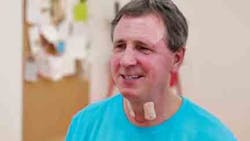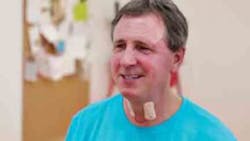Flexible, wearable sensors emerge as organizations look to markets
Printed, flexible, stretchable (P/F/S), and functional fabric (FF) sensors offer significant opportunities for IoT and wearable applications. For example, A new wearable designed to be worn on the throat could be a game-changer in the field of stroke rehabilitation. Developed in the lab of Northwestern University engineering professor John A. Rogers, in partnership with Shirley Ryan AbilityLab, the sensor is the latest in Rogers’ portfolio of stretchable electronics that are precise enough for use in advanced medical care and portable enough to be worn outside the hospital, even during extreme exercise.
“Stretchable electronics allow us to see what is going on inside patients’ bodies at a level traditional wearables simply cannot achieve,” Rogers said.1 “The key is to make them as integrated as possible with the human body.”
Courtesy of Northwestern University and Shirley Ryan AbilityLab
His new bandage-like throat sensor (Figure 1) measures patients’ swallowing ability and patterns of speech to aid in the diagnosis and treatment of aphasia. The tools that speech-language pathologists have traditionally used to monitor patients’ speech function—such as microphones—cannot distinguish between patients’ voices and ambient noise.
“Our sensors solve that problem by measuring vibrations of the vocal cords,” Rogers said. “But they only work when worn directly on the throat, which is a very sensitive area of the skin. We developed novel materials for this sensor that bend and stretch with the body, minimizing discomfort to patients.”
Shirley Ryan AbilityLab, a research hospital in Chicago, uses the throat sensor in conjunction with electronic biosensors—also developed in Rogers’s lab—on the legs, arms, and chest to monitor stroke patients’ recovery progress. The intermodal system of sensors streams data wirelessly to clinicians’ phones and computers, providing a quantitative, full-body picture of patients’ advanced physical and physiological responses in real time.
“One of the biggest problems we face with stroke patients is that their gains tend to drop off when they leave the hospital,” said Arun Jayaraman, research scientist at Shirley Ryan AbilityLab and a wearable technology expert. “With the home monitoring enabled by these sensors, we can intervene at the right time, which could lead to better, faster recoveries for patients.”
Getting to market in volume
Opportunities for P/F/S and FF sensors in wearable, IoT, and other high-volume applications is an interest of Roger Grace, president of Roger Grace Associates, a strategic marketing firm that supports its clients with front- and back-end analysis as well as product-launch planning and execution. In a recent presentation at Northeastern University2, he described his continuing and extensive research into the topic, including, thus far, 65 in-depth interviews with technology participants.
Driving functions include small size, plus low profile and weight—and the ability to conform to attaching surfaces, as is the case with the throat sensor. P/F/S and FF sensors can also offer low manufacturing costs based on existing batch-mode processing and can scale up to high-volume roll-to-roll or weaving manufacturing approaches, Grace said. “Recent market research has validated that a ‘smart systems solutions’ approach is required to best satisfy customers’ applications needs,” he added. “Adoption of a ‘systems solutions’ approach is mutually beneficial for the supplier and user.” Such a system will include sensors as well as interface circuits, microcontrollers, memory, power supplies or batteries, communications and networking capabilities (including antennas for wireless devices), and packaging and interconnect.
Grace said there are now a limited number of commercial companies mass producing P/F/S and FF sensors, with a limited number of parameters being measured—for instance, pressure and force. However, observers see potential for rapid growth, particularly in healthcare, wellness, and fitness applications.
As this print edition goes to press, Grace is planning to participate in a full-day symposium on P/F/S and FF sensors June 26 in conjunction with Sensors Expo & Conference in San Jose. He also plans to present at COMS 2018 Sept. 24-26 in Montreux, Switzerland, at Sensors Midwest Oct. 16-17 in Rosemont, IL, and at Sensors Summit Dec. 10-12 in San Diego.
References
1. “Stretchable electronics a ‘game changer’ for stroke recovery treatment,” Newswise, Feb. 16, 2018.
2. Grace, Roger, Printed/Flexible/Stretchable and Functional Fabric Sensors: Opportunities for Wearables, IoT and Other High-Volume Applications, Presentation at Northeastern University, Roger Grace Associates, April 11, 2018.

